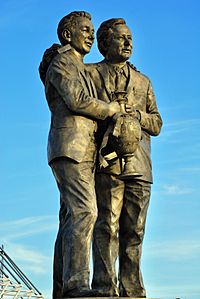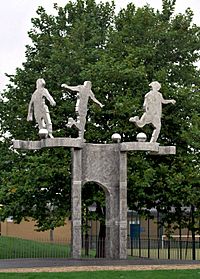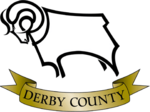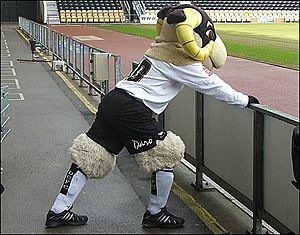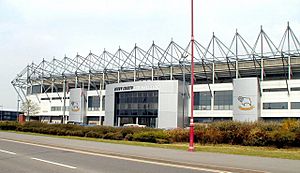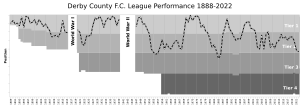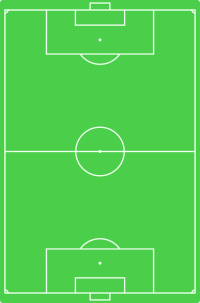Derby County F.C. facts for kids
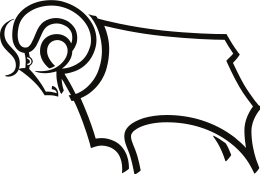 |
||||
| Full name | Derby County Football Club | |||
|---|---|---|---|---|
| Nickname(s) | The Rams | |||
| Short name | Derby | |||
| Founded | 1884 | |||
| Ground | Pride Park Stadium | |||
| Capacity | 33,597 | |||
| Owner | David Clowes | |||
| Chairman | David Clowes | |||
| Head coach | John Eustace | |||
| League | Championship | |||
| 2018–19 | Championship, 6th of 24 | |||
|
||||
Derby County Football Club is a professional football team from Derby, England. They play in the Championship, which is the second-highest league in English football.
Derby County was one of the 12 original teams that started the Football League in 1888. They are one of only nine clubs that have played in every single season of English league football. Most of their seasons have been in the top two divisions.
The club began in 1884. It was started by William Morley as a way to give players and fans something to do in winter. The team had its most successful period in the 1970s. During this time, they won the top league twice. They also played in big European competitions, reaching the semi-finals of the European Cup. Derby County also won the first FA Cup after World War II in 1946.
Since the 1890s, the team's home colours have been black and white. Their nickname is "The Rams." This nickname comes from their connection to a local military group that used a ram as its symbol. Derby County has a long-standing rivalry with Nottingham Forest. Their matches are known as the East Midlands derby.
Contents
- Club History
- How Derby County Started and Grew
- Early 1900s and Before World War II
- After World War II: Ups and Downs
- The Amazing Brian Clough Years
- Success and Decline After Clough
- 1980s Revival and Premier League Promotion
- Relegation and Financial Troubles
- Back to the Premier League and Straight Back Down
- Play-off Heartbreak, Administration, and Relegation
- Back to the Championship
- Club Identity
- Home Stadiums
- Fans and Rivalries
- League History
- Players
- Club Management
- Club Academy
- Derby County in Europe
- Records and Statistics
- Club Honours
- See also
Club History
How Derby County Started and Grew
Derby County F.C. was created in 1884. It was an offshoot of the Derbyshire County Cricket Club. The idea was to give players and fans a winter sport. It also helped the cricket club earn more money. The team first played at the cricket club's Racecourse Ground. Their very first match was a 6–0 loss to Great Lever in September 1884. Their first official competition was in the 1884–85 FA Cup, where they lost 7–0 to Walsall Town.
A very important game happened in the next season. Derby beat Aston Villa 2–0. This win helped Derby County become known in English football. It also helped them get invited to join the first Football League in 1888. The first league season began on September 8, 1888. Derby came back from being 3–0 down to beat Bolton Wanderers 6–3. They finished 10th out of 12 teams that season.
In 1891, Derby County joined with another local club, Derby Midland. This made Derby County the only professional football club in Derby. Steve Bloomer, who many believe is Derby County's best player ever, joined the club in 1892. In 1895, the club moved to a new stadium called the Baseball Ground. It was named this because it used to be a baseball field. This stadium was their home for the next 102 years. It was then that they started wearing their famous black and white home colours.
Derby's league results were not always the same. However, they finished second to Aston Villa in 1896. They also finished third several times. They were very strong in the FA Cup. They reached three finals in six years around 1900. But they lost all three: in 1898 to Nottingham Forest, in 1899 to Sheffield United, and in 1903 to Bury.
Early 1900s and Before World War II
In 1906, Steve Bloomer was sold to Middlesbrough because the club needed money. Derby then got relegated for the first time the next season. But under manager Jimmy Methven, they re-signed Bloomer. They got back into the First Division in 1911. In 1914, they were relegated again. However, they immediately won the Second Division to get promoted. World War I meant they had to wait until 1919 to play in the First Division again. After two seasons, they were relegated once more in 1921.
The club started a successful period when George Jobey became manager in 1925. After getting promoted in 1926, the team became very strong. They finished high in the league from the late 1920s through the 1930s. This included finishing as runners-up twice.
Derby was one of several clubs that closed down when World War II started. But they restarted in the early 1940s. This was thanks to the hard work of Jack Nicholas and Jack Webb. They also signed Raich Carter and Peter Doherty. These players had been stationed nearby during the war. When competitive football returned with the 1946 FA Cup, Derby was ready. They won their first major trophy, beating Charlton Athletic 4–1.
After World War II: Ups and Downs
The league started again the season after World War II. Under manager Stuart McMillan, Derby signed Billy Steel and Johnny Morris. They finished fourth in 1948 and third in 1949. But then the team slowly declined. They were relegated in 1953 after almost 30 years in the top league. They were relegated again in 1955. This sent them to the third level of English football for the first time.
Harry Storer helped Derby get back to the second level in 1957. But the club did not make much more progress for the next ten years.
The Amazing Brian Clough Years
In 1967, Brian Clough and Peter Taylor took over as managers. They led Derby to its greatest successes. When they started, Derby was 18th in the Second Division in 1968. Clough and Taylor brought in players like Alan Hinton, Roy McFarland, and John O'Hare. They also made the important signing of Dave Mackay. These changes helped the club finish 1st in 1969 and get promoted to the First Division.
Derby finished fourth in 1970. They were not allowed to play in Europe in 1971 due to money problems. But in 1972, they won their first ever Football League Championship! Derby did not win the title again the next season. However, they reached the semi-finals of the European Cup. They lost to Juventus.
Clough often spoke out against the football establishment. This caused problems with the club's board of directors. Clough and Taylor left in October 1973. They had such a big impact that 37 years later, a large bronze statue of them was put up outside Pride Park. It celebrates their amazing work.
Success and Decline After Clough
Even after Clough and Taylor left, Derby won the league again in the 1974–75 season. This was under their former player, Dave Mackay, who became manager. However, Derby's performance got worse towards the end of the 1970s. They were relegated to the Second Division in 1980. This happened after many managers, including former Manchester United boss Tommy Docherty, caused instability.
Derby played well in their first season back in Division Two. But soon, they faced serious money problems. Debts grew, and fewer fans came to games. Performances were also very poor.
Peter Taylor returned as manager in early 1983. He helped Derby avoid relegation that season. But he retired a year later, just before Derby was relegated to the Third Division. This was only the second time in their history. Luckily, Derby avoided going out of business. They were soon bought by a rich businessman named Robert Maxwell.
1980s Revival and Premier League Promotion
After being relegated to the Third Division in May 1984, Arthur Cox became manager. They missed promotion in Cox's first season. But then they won promotion two years in a row! They were back in the First Division for the 1987–88 season. More fans started coming to games as the club did better and its money situation improved.
New chairman Robert Maxwell invested a lot of money. Stars like Peter Shilton, Mark Wright, Dean Saunders, Trevor Hebberd, and Ted McMinn joined the club. They finished fifth in the 1988–89 season.
Maxwell stopped investing, and the club quickly declined. Fans became unhappy. This led to relegation back to the Second Division in 1991. The club finished last in the First Division with only five wins. At this time, local newspaper owner Lionel Pickering became the main owner. He took control just before Maxwell passed away in November 1991.
In 1992, Derby County paid £2.5 million for Notts County defender Craig Short. This was a huge amount for a player outside the top league at the time. Other expensive signings included strikers Tommy Johnson and Marco Gabbiadini. Cox resigned as manager in October 1993. Former player Roy McFarland took over. Derby reached the final of the Division One playoffs that season. But they lost to local rivals Leicester City. McFarland was fired a year later. His replacement was Jim Smith. He had a great record of promotions at his previous clubs.
The 1995–96 season started slowly. But signing defender Igor Štimac in the autumn was a turning point. Smith led the Rams to a second-place finish. This meant promotion to the Premier League, which is the top league in English football. During that season, it was announced that Derby would leave the Baseball Ground. After more than 100 years, they would move to a new, modern stadium.
After finishing 12th in their first season back in the top league, the club moved. They left the Baseball Ground, their home for 102 years. They moved into the new 33,597-seat Pride Park Stadium for the 1997–98 season. The Baseball Ground was torn down six years later. A memorial was later put up to remember its place in Derby's history.
Relegation and Financial Troubles
The club settled well into its new home. They finished in the top 10 for two years in a row. This was the first time since their peak in the 1970s. But then, a sudden decline happened around the year 2000. They struggled for three years. Smith resigned and was replaced by former players Colin Todd and John Gregory. Todd only lasted three months. The Rams were relegated in 2002 after six years in the top league.
Derby County's relegation led to serious money problems. They had to sell many important players. Gregory was later suspended from his manager duties. Former Ipswich Town boss George Burley was brought in. The club went into receivership. Then it was sold in October 2003 for £3 to a group led by Jeremy Keith.
After finishing 20th in the 2003–04 season, they improved a lot in the 2004–05 season. Derby finished fourth in the Championship. This meant they qualified for a promotion play-off spot. However, they lost in the semi-finals to Preston North End. Soon after, Burley resigned due to disagreements with the board. He was replaced by Bolton Wanderers coach Phil Brown. In January 2006, Brown was fired after a bad run of results. Terry Westley, the academy coach, took over until the end of the season. He saved Derby from relegation.
Back to the Premier League and Straight Back Down
In April 2006, a group of local business people bought the club. This group was led by former vice-chairman Peter Gadsby. They reduced the club's debt. They also brought Pride Park Stadium back under the club's ownership. In June 2006, former Preston North End boss Billy Davies became Derby County's new manager.
In his first season, Davies led Derby to the Championship play-offs. They beat Southampton on penalties in the semi-finals. Then they defeated West Bromwich Albion 1–0 at the new Wembley Stadium. This win secured their return to the Premier League. It also brought a big financial boost of £60 million.
Derby did not win any of their first five matches in the Premier League. They had one draw and four losses. Their first victory was a 1–0 win over Newcastle, with Kenny Miller scoring the only goal. In October 2007, Peter Gadsby stepped down as chairman. Adam Pearson, former owner of Hull City, took his place. Pearson immediately looked for international investors.
After a poor start to the season, manager Billy Davies left in November. Paul Jewell took over. But he could not save the club. Derby suffered the Premier League's earliest ever relegation in March. They also recorded the Premier League's lowest-ever points total. They equalled a 108-year Football League record of only one win in an entire season. This record was set by Loughborough in the 1899–1900 season. In January 2008, an international investment group bought Derby. Pearson remained as chairman.
Derby's home match against Sheffield United on September 13, 2008, got a lot of attention. It had been almost a year since Derby's last league win. This long run broke the English league record for most matches without a win. Just four days before the anniversary of their 1–0 win over Newcastle United, Rob Hulse scored against his old club. Derby won 2–1. This was Paul Jewell's first league win as Derby boss in his 27th attempt.
Jewell led the club to the League Cup semi-final. This was Derby's first major cup semi-final since 1976. They lost 4–3 to Manchester United over two games. But Jewell resigned as manager in December 2008. This was after a run of only two wins in 11 matches. Nigel Clough, son of former manager Brian Clough, replaced him. Nigel Clough led the club to 18th place and safety. After four years of finishing in the middle of the table, Clough was replaced by Steve McClaren in September 2013. McClaren led the club to a 3rd-place finish in the 2013–14 season. However, they lost the play-off final to Queens Park Rangers.
Play-off Heartbreak, Administration, and Relegation
The next season, local businessman Mel Morris became the club's owner. Morris initially spent a lot of money, more than ever before for Derby. He broke the club's transfer record four times in his first three years. But he also changed managers very often, with nine managers in six years from June 2015.
During this time, the club had three unsuccessful play-off campaigns. They failed in the semi-finals twice. They also lost in the 2019 final to Aston Villa. In May 2021, the club, managed by Wayne Rooney, just barely avoided relegation to League One. In May 2021, there were talks of penalties from the EFL. This was due to claims of breaking financial fair play rules. On July 8, 2021, the EFL put a transfer ban on the club. This left Rooney with only nine senior players under contract.
On September 17, 2021, the club's board announced that the club would go into administration. The EFL confirmed Derby would lose 12 points. On November 16, the club lost another nine points for breaking EFL accounting rules. An additional three-point deduction was suspended. Derby and related companies reportedly owed £29.3 million in taxes. They also owed £20 million to an investment group and about £15 million to other creditors. After a loss at QPR, Derby County was relegated to League One.
On June 26, 2022, David Clowes, a property developer from Derbyshire, bought Pride Park. His offer to buy the club was accepted. The administrators said Clowes's offer followed EFL rules. This meant Derby would not lose more points. The deal, and the club's exit from administration, was confirmed on July 1, 2022. Some limits on transfers were agreed by the EFL and Derby's new owners. Clowes paid £33 million to buy the club. This included £19.7 million paid to creditors. He also agreed to a £22 million deal to buy Pride Park and settle an old loan.
In September 2022, Derby appointed Rotherham United manager Paul Warne. The team tried for promotion but missed out on the League One play-offs, finishing 7th. The club's transfer ban was finally lifted in May 2023.
Back to the Championship
At the end of the 2023–24 season, Derby was promoted back to the Championship. They finished as runners-up with their highest ever points total. In September 2024, club owner David Clowes was reported to be talking with potential investors. These talks were about selling a majority share in Derby County. Sources confirmed that "several interested parties" had thought about investing.
On February 7, 2025, after a bad run of seven straight league defeats, Derby announced they had let manager Paul Warne go. They immediately started looking for a new manager. On February 13, 2025, Derby announced that former player John Eustace had been appointed as the new Head Coach. He left his job at Blackburn Rovers to join Derby, even though Derby was lower in the league table at the time.
Club Identity
Team Badge
Like most old football clubs, Derby County did not have a badge on their shirts at first. Their first badge was used in 1924. It was a round shield split into three parts. These parts represented the club, its fans, and the area. Each part had symbols linked to Derby city. There was a Tudor rose and a crown in one section. A buck in a park was in the second. A ram's head was in the last section. This badge was only on the players' shirts for two seasons. Then they went back to plain shirts.
By 1934, a new badge was introduced. This one was a traditional shield shape, also with three sections. The buck in the park was removed. The rose and crown were separated and each took a section. The ram's head stayed and was given the largest part of the shield. This badge never appeared on the players' shirts. The shield was changed in 1946. The rose and crown were removed. They were replaced with the letters "DC" (Derby County) and "FC" (Football Club). This badge was on the players' shirts from then on. However, only the ram's head was used from the late 1960s. The full shield was still the club's official logo.
A new club badge came out in 1971. It had a more modern design. With some changes, it is still used today. The first version had a stylish white ram facing left. The badge was slightly changed in 1979 to include "Derby County FC" under the ram. (But the ram was still on its own on away kits.) In 1982, the ram turned to face right, and the text was removed. The ram was surrounded by a laurel wreath. The words "Centenary 1984–1985" were printed underneath for the club's 100th season. The laurel was removed, and "Derby County FC" returned the next season.
In 1993, the ram faced left again, and the text was removed once more. From 1995, the ram faced right and was inside a diamond shape. A gold banner underneath said "Derby County FC." The year "1884" (when the club started) was below that. The design changed again in 1997 (see left). The ram now faced left. The gold banner simply said "Derby County." The diamond and the year were removed.
Ten years later, in 2007, the badge was changed again. The ram still faced left. "Est. 1884" was now in the middle of a round frame. "Derby County Football Club" was in gold letters around it. The colours were changed to black and white in 2009 (see top of page). In July 2012, the club said they would only show the famous ram outline on future shirts. In July 2013, this traditional ram became the club's full logo again.
Team Colours
Derby County's first colours (right) were amber, chocolate, and blue. But by the 1890s, the club had chosen its traditional black and white colours. These are still used today. In the 1970s and 1980s, home match colours were white shirts with small blue or red details. They had blue shorts and socks that were blue, red, white, or a mix.
The colours of away kits have changed a lot. They are usually yellow/gold or blue. For the 2008–09 season, the away kit was bright green. The club also introduced a surprise third kit in August 2008. It looked like the club's away kit from the 1970s, with blue and white stripes. It reminded fans of the Argentina national team strip. This style was brought back because fans said it was one of their favourite old kits.
|
|
| 1884–94 kit |
| Period | Kit Sponsor | Shirt Sponsor |
|---|---|---|
| 1973–1979 | Umbro | None |
| 1979–1980 | Le Coq Sportif | |
| 1980–1981 | British Midland | |
| 1981–1982 | Patrick | |
| 1982–1984 | Patrick | |
| 1984–1985 | Admiral | Bass Brewery |
| 1985–1986 | OSCA | |
| 1986–1987 | Sportsweek | |
| 1987–1992 | Umbro | Maxwell Communications |
| 1992–1993 | Auto Windscreens | |
| 1993–1994 | Bukta | |
| 1994–1995 | Rams Pro Wear | |
| 1995–1998 | Puma | Puma |
| 1998–2001 | EDS | |
| 2001–2005 | Erreà | Marston's Pedigree |
| 2005–2007 | Joma | Derbyshire Building Society |
| 2007–2008 | Adidas | |
| 2008–2010 | Bombardier | |
| 2010–2012 | buymobiles.net | |
| 2012–2014 | Kappa | |
| 2014–2017 | Umbro | Just Eat |
| 2017–2018 | Avon Tyres | |
| 2018–2022 | 32Red | |
| 2022–2023 | NSPCC | |
| 2023–2024 | Host and Stay | |
| 2024– | Puma | FanHub |
Club Mascot
Derby's mascot is a ram named Rammie. Rammie helps the club connect with fans and the local area. He visits schools to promote reading and attends charity events. Rammie was chosen as a friendlier symbol than the club's old links to the British Army.
Rammie was the first full-time mascot in British football. He often does penalty shoot-outs with fans at half-time, acting as the goalkeeper. He also gets the crowd excited before matches and cheers on the Derby fans. Rammie is very popular. In 2005, he released his first DVD, where he read stories in the Derbyshire countryside.
Later, Rammie was joined by his sister, Ewie. However, Ewie did not stay at Pride Park for long. She went on a "vacation" to the United States. She returned on October 3, 2015, at a home match against Brentford.
Home Stadiums
Derby County's first home stadium was the County Cricket Ground. It was also known as the Racecourse Ground. The club played there from 1884 to 1895. This ground was good enough to host the first FA Cup final outside London in 1886. It also hosted an England international match. But there were arguments about scheduling games between the football and cricket clubs. So, when the chance to play at Sir Francis Ley's Baseball Ground came up, the club took it.
Fans often called the Baseball Ground "the BBG." The club moved there in 1895 and stayed for 102 years. At its busiest in the late 1960s, the ground could hold about 42,000 people. The club's record attendance was 41,826. This was for a 5–0 win against Tottenham Hotspur on September 20, 1969. Over the next 15 years, more seats were added, and the capacity dropped to 26,500 by 1985.
After the Taylor Report in 1989, all stadiums had to have only seats. The Baseball Ground's capacity shrank to just 18,500 by the mid-1990s. This was not enough for the ambitious club. Chairman Lionel Pickering first hoped to rebuild the Baseball Ground to hold 26,000 fans. He also turned down offers for two other sites in Derby. But in February 1996, he announced plans to move to a new stadium at Pride Park. The last first-team game at the Baseball Ground was in May 1997. It was a 1–3 home loss to Arsenal. The ground continued to host reserve matches until 2003.
Derby's new stadium, Pride Park Stadium, was officially opened by the Queen on July 18, 1997. A friendly match against Italian club Sampdoria followed on August 4.
Derby is the only club to have had three home grounds host full England international matches. England beat Ireland 9–0 at the Racecourse Ground in 1895. They beat Ireland again, 2–1, at the Baseball Ground in 1911. Most recently, Pride Park hosted England's 4–0 win over Mexico in May 2001.
Pride Park was renamed the iPro Stadium on December 7, 2013. This was part of a 10-year, £7 million sponsorship deal with a sports drink company. In early 2017, it went back to its original name, Pride Park Stadium.
Clowes Developments (UK) Ltd bought Pride Park from Mel Morris on June 17, 2022.
Fans and Rivalries
Club Support
Derby is often called a "passionate football town" by other fans and the media. Tony Francis of The Daily Telegraph said, "Derby is a passionate football town... Even in Division Two, it's a reasonable bet that crowds at Pride Park would not fall far below 30,000. It's historical, it's geographical, it's in the blood. Some places have it, some don't."
During the 2007–08 Premier League season, Derby County fans were often called the best in England. This was because they stayed loyal despite the club's very difficult season. Almost every home match at Pride Park Stadium was sold out. The club also had many fans who travelled to away games. They were named fans of the season by many national news outlets. They won an award from Nuts magazine. A 2008 survey by Sky Sports Magazine named them the most loyal supporters in the country. In 2013, Derby fan Nick Webster was voted Championship Fan of the Year.
Statistically, the club had the 12th-highest average attendance in England in the 2007–08, 2008–09, and 2009–10 seasons. This was despite having only the 15th-largest club ground. In 2008–09, they had the most support in the Championship. Their average attendance was higher than nine Premier League clubs. Since moving to Pride Park Stadium in 1997, Derby's average attendance has never dropped below 23,000. They have finished in the top 20 for highest average attendances in 20 out of 25 seasons. This is despite spending most of that time in the second division. In the 2023-24 season, Derby was the 6th best-supported team in the entire EFL. They had an average crowd of 27,278, even though they were playing in the third division. They also had a higher average attendance than six Premier League clubs.
Derby's famous supporters include actors George Clooney and Robert Lindsay. Also, former Labour MP Dennis Skinner, Irish singer Niall Horan, Blur guitarist Graham Coxon, The Gaslight Anthem guitarist Alex Rosamilia, boxers Sandy Ryan and Zach Parker, and actor Jack O'Connell. It has been said that O'Connell has convinced other celebrities to support the club, including actress Angelina Jolie and model Cara Delevingne.
Team Rivalries
Derby's main rival clubs are Nottingham Forest, Leicester City, and Leeds United.
Forest, located in Nottingham, about 14 miles east of Derby, are by far the fiercest rivals. A 2008 survey called this rivalry the 11th-largest in English football. It showed that nine out of 10 fans from both clubs see the other as their biggest rival. A 2020 survey listed it as joint-12th. Matches between the teams are known as East Midlands derbies. The winning team gets the Brian Clough Trophy. The rivalry grew a lot in the 1970s. This was because former Derby manager Brian Clough took over at Forest, which angered Derby fans.
The rivalry with Leicester comes from their close locations. Also, Leicester beat Derby in the 1994 play-off final.
Leeds United is disliked because of ongoing tension from the early 1970s. At that time, Derby and Leeds were two of the top English teams. There was also clear hostility between their managers, Brian Clough and Don Revie. This rivalry is stronger for Derby fans. While Derby sees Leeds as their second or third-biggest rivals, Leeds fans focus more on their dislike of Manchester United and Chelsea. However, the rivalry became more intense in the 2018–19 season. This was after the 'Spygate' incident, the play-off semi-final, and increased bad feelings between the managers, staff, and fans of both clubs.
A 2019 study called 'The League of Love And Hate' reported Derby fans' top five rivals: Nottingham Forest (88%), Leicester City (64%), Leeds United (63%), Stoke City (43%), and Aston Villa (30%). Derby itself appeared in the top five rivals for Forest (1st – 77%), Leicester (2nd – 60%), Burton Albion (3rd – 56%), Leeds (5th – 30%), and Stoke (5th – 28%).
League History
Derby was one of the twelve founding members of the Football League. They are also one of only ten clubs that have played in every single season of English league football. The club has mostly played in the top two divisions. However, they have had three separate two-year periods in the third division (1955-57, 1984-86, and 2022-24).
The club's longest time in the top league was 27 years, from 1926 to 1953. However, the club only played in 21 continuous seasons of Division One during this time. This is because competitive football was stopped between 1940 and 1946 due to World War II.
The club is currently in its longest period outside the top league. They are playing in the second division in the 2024–25 season. This is their 17th season in a row without playing in the top league. This breaks their old record of 16 continuous seasons between 1953 and 1969.
|
|
|
|
L1 = Level 1 of the football league system; L2 = Level 2 of the football league system; L3 = Level 3 of the football league system.
- Seasons spent at Level 1 of the football league system: 65
- Seasons spent at Level 2 of the football league system: 55
- Seasons spent at Level 3 of the football league system: 6
(up to and including 2024–25)
Players
Current Squad
|
|
Players on Loan
|
Women's Team
Famous Former Players
Premier League Hall of Fame
The Premier League Hall of Fame celebrates top football players and managers. These are people who played and managed in the Premier League, England's top league. It started in 2020. It honors players and managers who achieved great success and made a big impact since 1992. Three former players or managers linked to Derby County are in the Hall of Fame.
- 2021 –
 Frank Lampard
Frank Lampard - 2022 –
 Wayne Rooney
Wayne Rooney - 2024 –
 Ashley Cole
Ashley Cole
English Football Hall of Fame Members
Several former players and managers connected to Derby County are in the English Football Hall of Fame. This Hall of Fame was created in 2002. It celebrates those who reached the very top of English football. To be considered, players or managers must be 30 years old or older. They must also have played or managed for at least five years in England.
- 2002 –
 Brian Clough
Brian Clough  Peter Doherty
Peter Doherty  Peter Shilton
Peter Shilton  Dave Mackay
Dave Mackay - 2008 –
 Steve Bloomer
Steve Bloomer - 2010 –
 Francis Lee
Francis Lee - 2013 –
 Raich Carter
Raich Carter - 2014 –
 Hughie Gallacher
Hughie Gallacher - 2015 –
 Paul McGrath
Paul McGrath - 2016 –
 John Robertson
John Robertson - 2017 –
 Frank Lampard
Frank Lampard - 2025 –
 Ashley Cole
Ashley Cole
Football League 100 Legends
The Football League 100 Legends is a list of "100 legendary football players." The Football League created it in 1998. It celebrated the 100th season of League football. Eight former Derby players made this list.
 John Goodall
John Goodall Steve Bloomer
Steve Bloomer Hughie Gallacher
Hughie Gallacher Raich Carter
Raich Carter Peter Doherty
Peter Doherty Dave Mackay
Dave Mackay Peter Shilton
Peter Shilton Paul McGrath
Paul McGrath
Player of the Decade (1970s–2010s)
To celebrate 50 years since Derby won the First Division Championship, the BBC asked fans to vote. They wanted to find the best Rams players for five decades since 1972. For the 1970s, Kevin Hector got the most votes. For the 1980s, it was Bobby Davison. For the 1990s, Dean Saunders. For the 2000s, Mart Poom. And for the 2010s, Craig Bryson.
Club Management
Coaching Positions
- Head coach: John Eustace
- Assistant head coach: Matt Gardiner
- First team coach: Keith Downing
- Part-time coach: Steve Round
- Head of Goalkeeping: Paul Clements
- Academy manager: Matt Hale
- Head of recruitment: Mark Thomas
Board of Directors and Ownership
- Owner and Chairman: David Clowes
- Club Secretary and Board Member: Richard Tavernor
- Board Member: Ian Dickinson
- CEO: Stephen Pearce
- Club Ambassadors: Roy McFarland; Roger Davies
Managerial History
Below is a list of all the permanent managers Derby County has had. This starts from when Harry Newbould was appointed in 1900. In the 12 years before Newbould, a club committee chose the team. This was a common practice for football clubs back then.
|
|
|
Club Academy
Moor Farm Training Ground
Derby County's academy is called Moor Farm. It is a special training complex built near the city area of Oakwood. It was built in 2003 and cost £5 million. It replaced the club's old academy, The Ram-Arena. Moor Farm covers 50 acres and has six full-sized training pitches. It also has an indoor pitch, a gym, a restaurant, and a laundry.
When the academy opened, then-Chairman Lionel Pickering said he wanted "at least eight players from the Academy... in the first-team within three years." This goal was not fully met. However, the academy did produce many notable players. These include England international midfielder Tom Huddlestone. Also, Wales international defender Lewin Nyatanga. And Northern Ireland international goalkeeper Lee Camp. Plus, England under-21s players Miles Addison and Lee Grant. And England under-19 player Giles Barnes.
In April 2009, new manager Nigel Clough decided to change the academy. He appointed former Derby players Darren Wassall and Michael Forsyth. He also brought in John Perkins, who was the Academy director at Wolverhampton Wanderers. This was after Phil Cannon, David Lowe, and Brian Burrows left. After these changes, and with £1 million more invested each year, many players joined the first team. By the 2010–11 season, almost a third of the Derby squad were academy graduates. Mason Bennett set a club record for the youngest first-team appearance. He made his full debut at Middlesbrough on October 22, 2011. He was only 15 years and 99 days old.
This helped make the academy's reputation stronger. It also supported CEO Tom Glick's goal to make Moor Farm "the academy of choice in the Midlands." In August 2012, Derby's academy became a Tier 2 academy. This was under the new Elite Player Performance Plan. It was given Tier 1 status two years later in July 2014. The academy remained a focus during Mel Morris's ownership. At the end of the 2019–20 season, Derby had given more first-team minutes to players under 21 than any other club in the Football League Championship. Academy graduates like Max Bird, Louie Sibley, Jason Knight, Jayden Bogle, Morgan Whittaker, and Lee Buchanan played a total of 7,946 minutes in the league. When talking about goals for the 2020–21 season, Morris said, "We are not going to see a team of 11 players from the Academy featuring this season (2019/20) but the target for next season (is) 50% of our starting 11 should be Academy players. That (is) our target, and I think there is a possibility we could get there."
Derby County in Europe
Derby first played in Europe in the 1972–73 European Cup. They qualified after winning the 1971–72 First Division Title. They reached the semi-finals but lost 3–1 on total score to Juventus. They had qualified for the 1970–71 Fairs Cup after finishing 4th in the 1969–70 First Division. But they were banned from the competition due to money problems. The 1970s was Derby County's best time in English football. They qualified for Europe in three of the next four seasons. They played in the UEFA Cup or the European Cup in each of the three seasons between 1974–75 and 1976–77.
The club then quickly declined. They have not appeared in top European competitions since. However, they finished 5th in the 1989 First Division. This would have given them a spot in the 1989–90 UEFA Cup. But English clubs were banned from Europe after the Heysel Stadium Disaster.
Outside of major competitions, the club played in the Anglo-Italian Cup. This was between 1992–93 and 1994–95. They reached the final in 1993, losing 3–1 to Cremonese at Wembley.
Records and Statistics
Kevin Hector holds the record for most appearances for Derby County. He played 589 times in two periods with the club between 1966 and 1982. He is ahead of Ron Webster, who played 535 times. If we only count league appearances, Hector is still first with 486 games. Jack Parry is second, playing 483 times from 1948 to 1967.
The club's all-time top goalscorer is Steve Bloomer. He scored 332 goals for the club in two periods between 1892 and 1914. He is over 100 goals ahead of Kevin Hector, who is second with 201 goals. Jack Bowers holds the club record for most goals in a single season. He scored 43 goals (35 in the league and 8 in the FA Cup) during the 1932–33 season. The record league scorer for a season is Jack Bowers and Ray Straw with 37 goals. This happened in the 1930–31 and 1956–57 seasons.
The club's record attendance is 41,826. This was for a First Division match against Tottenham Hotspur at the Baseball Ground on September 20, 1969. Derby won that game 5–0. This record is unlikely to be broken soon. Derby's current stadium, Pride Park Stadium, can only hold 33,597 spectators. The record attendance at Pride Park for a competitive Derby County match is 33,378. This was for a Premier League match against Liverpool on March 18, 2000. The largest crowd to ever watch a Derby County game was 120,000. This was when Derby County played Real Madrid at the Santiago Bernabéu Stadium in the 1975–76 European Cup.
Derby's very poor 2007–08 Premier League season set a league record. They had the lowest points total in a league campaign (3 points for a win). They collected only 11 points from 38 games (P38 W1 D8 L29). They also equalled Loughborough's 1899-1900 record of only 1 win in a season. As of the end of the 2024-25 season, they share several Premier League records.
- Fewest home wins in a season (1, shared with Sunderland (2005-2006), Ipswich Town (2024-25), and Southampton (2024-25)).
- Fewest away wins in a season (0, shared with five other clubs).
- Least goals in a season (20, shared with Sheffield United (2023-24)).
- Worst Goal Difference (-69, shared with Sheffield United (2023-24)).
The bad run from the 2007–08 season continued into the next season. Derby did not get their first league win until matchday 5. This set a record for most consecutive league games without a win (36). This record is now shared with Macclesfield Town.
Derby also shares the record (with Watford) for the biggest loss in an FA Cup final. They lost 6–0 to Bury in 1903.
All-time Best XI
To celebrate the club's 125th Anniversary, a vote was held in 2009. Each month, fans voted to choose the club's official All Time XI (best team). It started in February 2009 with the goalkeeper. Over the next eight months, fans picked a team using a 4–4–2 formation. The vote for the manager was in December. Voting closed on the 25th of each month, and the winner was announced a few days later.
| Player | Position | Years at Club | Ref |
|---|---|---|---|
| Colin Boulton | Goalkeeper | 1964–1978 | |
| Ron Webster | Right back | 1960–1978 | |
| Roy McFarland | Centre back | 1967–1981; 1983–84 | |
| Igor Štimac | Centre back | 1995–1999 | |
| David Nish | Left back | 1972–1979 | |
| Stefano Eranio | Right Wing | 1997–2001 | |
| Archie Gemmill | Centre Midfielder | 1970–1977; 1982–1984 | |
| Alan Durban | Centre Midfielder | 1963–1973 | |
| Alan Hinton | Left Wing | 1967–1975 | |
| Steve Bloomer | Centre forward | 1892–1906; 1910–1914 | |
| Kevin Hector | Centre forward | 1966–1978; 1980–1982 | |
| Brian Clough | Manager | 1967–1973 |
Club Honours
Note: The names of leagues and divisions in English football have changed over time. Here, they are grouped by their level in the English football league system when they were won. This helps to compare the achievements easily.
League Titles
- First Division (level 1)
- Champions: 1971–72, 1974–75
- Runners-up: 1895–96, 1929–30, 1935–36
- Second Division / First Division / Championship (level 2)
- Champions: 1911–12, 1914–15, 1968–69, 1986–87
- Runners-up: 1925–26, 1995–96
- Play-off winners: 2007
- Third Division North / Third Division / League One (level 3)
- Champions: 1956–57
- Runners-up: 1955–56, 2023–24
- Promoted: 1985–86
Cup Wins
- FA Cup
- Winners: 1945–46
- Runners-up: 1897–98, 1898–99, 1902–03
- FA Charity Shield
- Winners: 1975
- Texaco Cup
- Winners: 1971–72
- Anglo-Italian Cup
- Runners-up: 1992–93
- Watney Cup
- Winners: 1970
See also
 In Spanish: Derby County Football Club para niños
In Spanish: Derby County Football Club para niños


